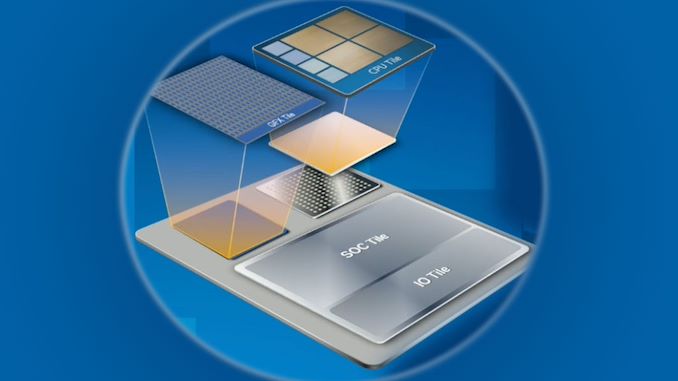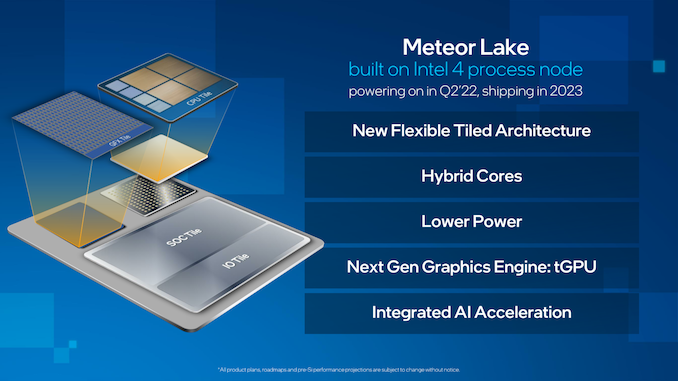Intel: Meteor Lake & Intel 4 Process Now Ramping for Production
by Ryan Smith on April 27, 2023 4:50 PM EST- Posted in
- CPUs
- Intel
- Meteor Lake
- Intel 4

As part of today’s Q1’2023 earnings announcement from Intel, the company is offering a brief update on the state of its upcoming chips and manufacturing nodes. Key among these disclosures is a status update on Meteor Lake, Intel’s next-generation client processor (and first disaggregated chiplet CPU), as well as the Intel 4 process node that it will be built upon.
According to Intel, the company is on track to launch Meteor Lake in the second half of the year. And more specifically, at this point Meteor Lake is now in production and ramping alongside the new Intel 4 process.
The basis of what we expect will be sold as Intel’s 14th generation of Core processors, Meteor Lake is a critical part for Intel that represents several firsts for the company. It’ll be the first client CPU using chiplets, but also the first heterogenous chiplet CPU from the company, using different chiplets for I/O, CPU cores, graphics, and more. And on the manufacturing side of matters, it’s going to be the lead product for Intel’s next-generation EUV-based Intel 4 process node, as well as Intel’s biggest use of Foveros 3D die stacking technology yet – and the first attempt to do so for a relatively cheap, mass-market processor.
Intel’s last significant update on Meteor Lake came almost exactly a year ago, when the company announced during their Q1’2022 earnings report that it had been successfully powered on for testing. So at a year later, Intel is now making final preparations for a product launch later this year. The official launch window is still in the second half of the year – Intel client processor ramp-ups take several months even without all-new manufacturing technologies in play – so we expect Intel will announce more concrete details on that launch some time in the third quarter.
Source: Intel











18 Comments
View All Comments
edzieba - Friday, April 28, 2023 - link
Not /quite/ Intel's first disaggregated consumer CPU: that would be Lakefield. Big/little cores, multiple dies of different process nodes, TSVs, and Foveros, all got their test run there.brucethemoose - Friday, April 28, 2023 - link
Is this the gen with a M1 Pro-esque 256-bit part, or is that Arrow Lake?I would really love an M1 Max-ish desktop part for running LLMs... without being locked to OSX or Metal.
lefty2 - Friday, April 28, 2023 - link
Meteor lake and Intel 4... (yeah, but don't tell anyone that it's mostly TSMC fabbed, shuu!)Yojimbo - Friday, April 28, 2023 - link
The CPU tile is the important tile. And Intel readily admits that TSMC has been ahead of Intel in process technology the past few years. If Intel finds it cost beneficial to use TSMC for the I/O and SOC tiles, which are produced on older nodes, what does that have to do with Meteor Lake or Intel forging ahead with their cutting edge nodes with Intel 4?It's interesting that they prefer TSMC for the GPU tiles, though. I wonder if that will change once they are producing in volume on 18A. I say that because Intel seems to want to compete with TSMC for Nvidia's orders. Anyway, get used to it, because Intel plans to use other foundries for various parts whenever it makes sense to do so. Intel has been one of TSMC's largest customers and will likely continue to be.
name99 - Monday, May 1, 2023 - link
The reason which fab is doing what matters is- GPUs care mainly about density
- CPUs (in the intel design style) care about high frequency, power be damned
The MTL split suggests that i4 can't achieve high density. Or can't achieve it at decent prices,
Which is significant for both foundry (most customers skew more to prioritizing density over frequency) and for the expected cost of future Intel devices (which will be competing against both AMD on TSMC and various ARM on various foundries).
The whole point of The Innovator's Dilemma, a point which old Intel understood well, is that you cannot save your business by retreating upmarket, selling products are somewhat better performing, yes, but a LOT more expensive. Didn't work for IBM, didn't work for DEC, didn't work for SGI or SUN. (Kinda works for Apple, but they are slightly more expensive, not a LOT more, and provide an associated bundle of functionality that people consider worth the cost; they're not selling a commodity the way Intel is.)
Intel seems destined to follow the IBM track of being able to boast "#1 fastest" but at prices almost no-one is willing to pay... Certainly every new detail we learn suggests that Intel's next designs may be that few percent faster than AMD; but if that requires twice the cost (which is where all the evidence points), well, AMD, get ready for buying all the TSMC capacity Apple hasn't already snarfed up...
SiliconFly - Saturday, May 6, 2023 - link
Your first statement is right. Intel 4 doesn't support HD libraries. It's a client only node purely built for performance only at the cost of density. Not suitable for GPUs. Intel's first pure intel foundry based GPU is probably Druid based on 18A.Der Keyser - Saturday, May 6, 2023 - link
Does it matter? Every currently known end user device type and general cloud computing server is heading for ARM based infrastructure anyways. We are past the point where the software made a switch impossible, so it’s only a matter of years before everything mainstream is ARM because of the power envelope and cost. x86 is deathspiraling for the volume market.SiliconFly - Saturday, May 6, 2023 - link
AMD uses TSMC. It's not like they have a monopoly or exclusivity with TSMC. If others want to use it, they very well can.